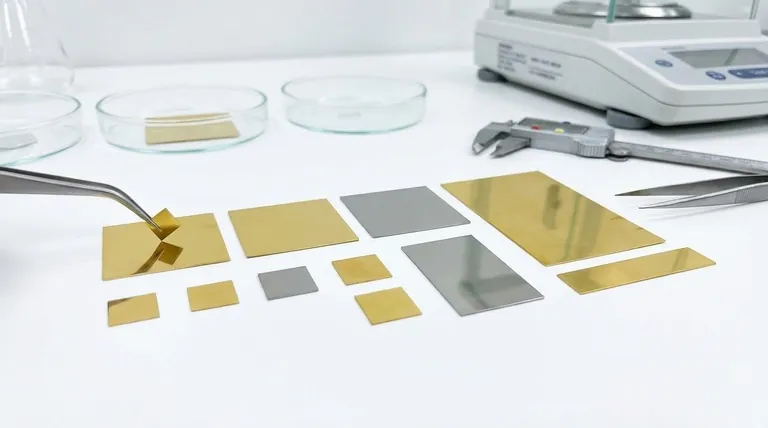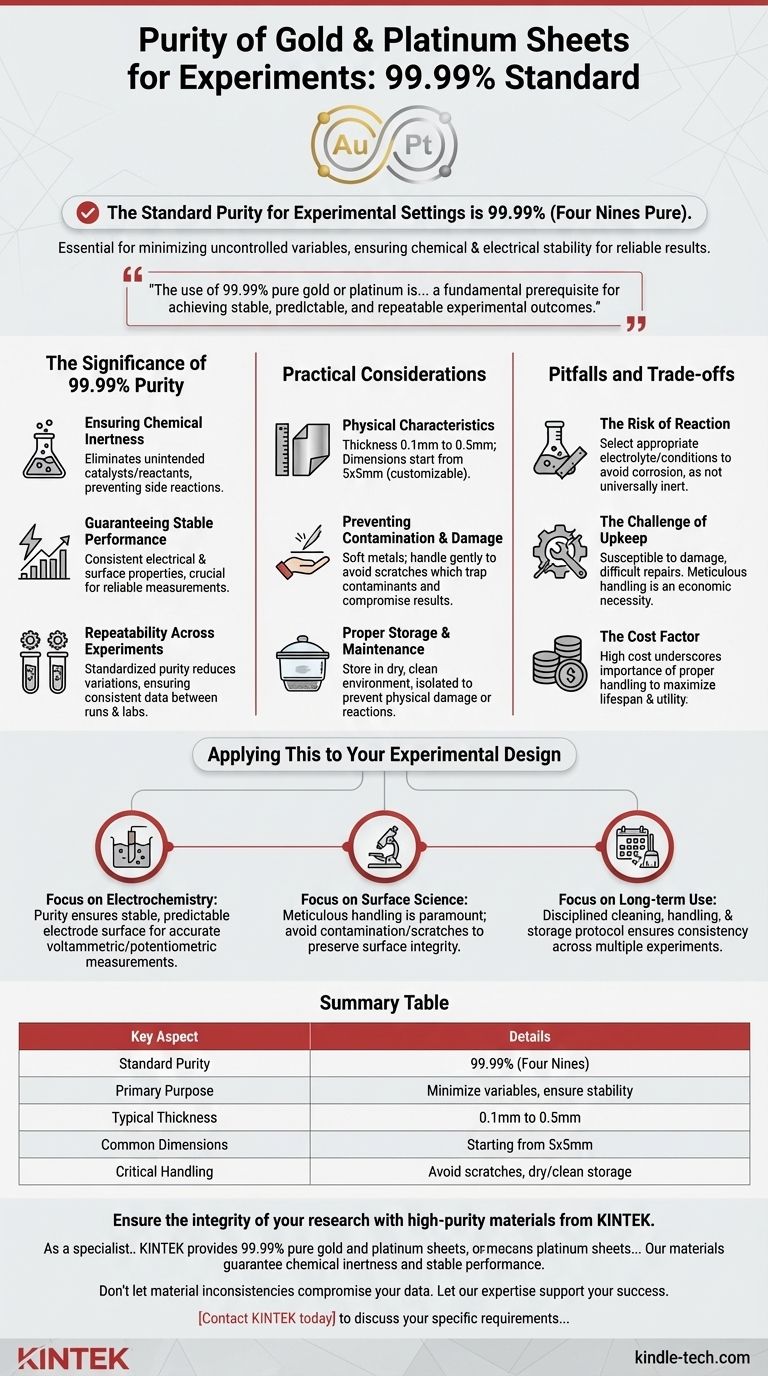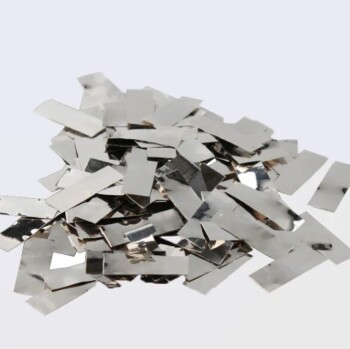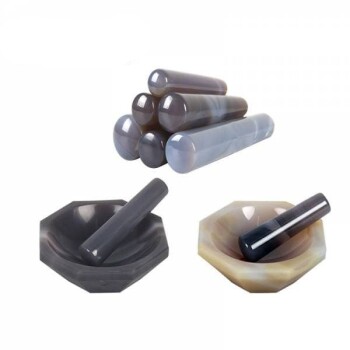The standard purity for gold and platinum sheets used in experimental settings is 99.99%. This specific, high-purity level, often referred to as "four nines" pure, is a critical requirement. It is essential for minimizing uncontrolled variables and ensuring the chemical and electrical stability needed for reliable scientific results.
The use of 99.99% pure gold or platinum is not merely a quality standard; it is a fundamental prerequisite for achieving stable, predictable, and repeatable experimental outcomes. The integrity of your results depends directly on the integrity and handling of these materials.

The Significance of 99.99% Purity
Achieving reliable data in a controlled experiment requires eliminating as many unknown variables as possible. The purity of your electrode or sample material is one of the most significant factors you can control.
Ensuring Chemical Inertness
Impurities, even at a fraction of a percent, can act as unintended catalysts or reactants. In sensitive electrochemical experiments, these contaminants can introduce side reactions, skewing measurements and leading to incorrect conclusions.
A purity of 99.99% ensures the material behaves as expected—as either gold or platinum—without interference from other elements.
Guaranteeing Stable Performance
The electrical and surface properties of a metal are directly tied to its composition. Impurities can alter conductivity, surface potential, and reaction kinetics.
By using a highly pure material, you ensure that its performance remains stable and consistent, which is the cornerstone of repeatable measurements.
Repeatability Across Experiments
Using a standardized purity level allows for greater consistency between different experimental runs and even different labs. It ensures that a key component of the setup, the electrode sheet itself, is not a source of variation.
Practical Considerations for High-Purity Metals
Beyond purity, the physical form and handling of these sheets are critical to their effective use. Understanding these practical aspects prevents costly mistakes and preserves the material's integrity.
Physical Characteristics
These sheets are typically available in square or rectangular shapes with a thickness ranging from 0.1mm to 0.5mm. Common dimensions start from 5x5mm, but custom sizes can be sourced for specific apparatuses.
Preventing Contamination and Damage
Both gold and platinum are very soft metals. It is crucial to handle them gently to prevent scratches or deformation. A scratch not only changes the surface area but can also trap contaminants that compromise experimental results.
Repairs to these sheets are often complex and may not restore the original uniform surface, making careful handling a priority.
Proper Storage and Maintenance
To maintain their high purity, sheets must be stored in a dry, clean environment. They should be isolated from other materials to prevent physical scratches or unintended chemical reactions from contact.
Understanding the Pitfalls and Trade-offs
While essential for quality research, using high-purity metals involves challenges that must be managed. Awareness of these factors is key to successful experimental design.
The Risk of Reaction
Even high-purity gold and platinum are not universally inert. It is critical to select an appropriate electrolyte and experimental conditions that are non-reactive with the metal sheet to prevent corrosion or dissolution.
The Challenge of Upkeep
The softness of these metals makes them susceptible to damage. Their high value and the difficulty of repair mean that meticulous handling is not just a recommendation but an economic necessity.
The Cost Factor
The primary trade-off is cost. Sourcing and fabricating 99.99% pure noble metals is an expensive undertaking. This cost underscores the importance of proper handling and storage to maximize the lifespan and utility of the investment.
Applying This to Your Experimental Design
Your specific research goals will determine which aspect of these materials demands the most attention.
- If your primary focus is electrochemistry: The 99.99% purity is your guarantee of a stable, predictable electrode surface, which is essential for accurate voltammetric or potentiometric measurements.
- If your primary focus is surface science: Meticulous handling is paramount, as any surface contamination, oxidation, or physical scratch will directly invalidate your observations.
- If your primary focus is long-term or repeated use: A disciplined protocol for cleaning, handling, and storage is necessary to preserve the sheet's integrity and ensure consistency across multiple experiments.
Ultimately, understanding these material properties ensures the integrity of your components directly translates to the integrity of your results.
Summary Table:
| Key Aspect | Details for Gold & Platinum Sheets |
|---|---|
| Standard Purity | 99.99% (Four Nines) |
| Primary Purpose | Minimize variables, ensure chemical/electrical stability |
| Typical Thickness | 0.1mm to 0.5mm |
| Common Dimensions | Starting from 5x5mm (custom sizes available) |
| Critical Handling | Avoid scratches, store in a dry, clean environment |
Ensure the integrity of your research with high-purity materials from KINTEK.
As a specialist in laboratory equipment and consumables, KINTEK provides researchers with the 99.99% pure gold and platinum sheets essential for accurate and repeatable experiments. Our materials guarantee the chemical inertness and stable performance your work demands.
Don't let material inconsistencies compromise your data. Let our expertise support your success.
Contact KINTEK today to discuss your specific requirements for high-purity metals and laboratory solutions.
Visual Guide

Related Products
- High Purity Gold Platinum Copper Iron Metal Sheets
- Platinum Sheet Electrode for Battery Lab Applications
- Platinum Sheet Electrode for Laboratory and Industrial Applications
- High-Purity Titanium Foil and Sheet for Industrial Applications
- High Purity Zinc Foil for Battery Lab Applications
People Also Ask
- How hot can a metal surface get in the sun? The Surprising Science Behind Extreme Heat
- What are the advantages disadvantages and uses of sheet metal? The Ultimate Guide to Material Selection
- What is the difference between metallic and non-metallic coating? A Guide to Sacrificial vs. Barrier Protection
- Where is soldering commonly used? From Everyday Electronics to Industrial Applications
- What are the guidelines for using gold or platinum sheets during an experiment? Ensure Precise and Reliable Results

















